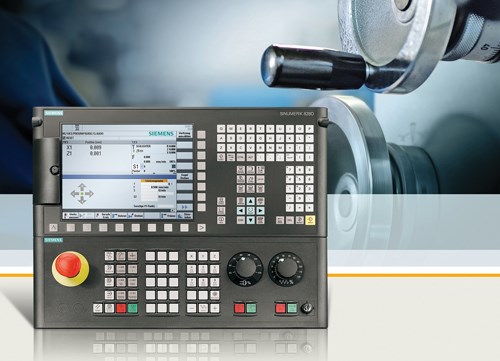Integrated CNC Technology Solutions
Manufacturing is seeing increased integration of product development and production processes with the benefit of innovative, high-performance software systems. This decisive step is an indication of accelerated growth.
Industrial corporations are facing deep-rooted changes in the world of manufacturing. These changes are taking place alongside increasing integration of product development and production processes with the benefit of innovative, high-performance software systems. This decisive step is an indication of accelerated growth in manufacturing.
In Siemen’s own ongoing development of its CNCs, the company has set its sights on optimizing the high-end Sinumerik 840D si for technological requirements. The Sinumerik MDynamics technology package includes intelligent function extensions for three-axis and five-axis milling applications to help increase machine efficiency, particularly in high-speed cutting (HSC). Reliable protection against involuntary collisions is ensured by the “Collision Avoidance” function.
Featured Content
In addition, the new “Nodding Compensation” compile cycle ensures increased precision during workpiece machining. Hardware architecture and intelligent control algorithms ensure dynamic performance and accuracy when machining on multitasking machines.
Collision Protection
Preventing the collision of machine components in the working area of the machine, the Collision Avoidance function is concentrated on the most critical situations arising in practice—during machine setup or in case of interrupted machining. It other words, it is most effective in times when the operator intervenes in the process.
The 3D real-time collision monitoring function is active even with complex machining operations such as five-axis simultaneous milling or turning with B axis. In this context, static and mobile machine components, as well as the tool cutting edge, are effectively monitored for collisions. The 3D visualization system allows users to display the complete machining process, including the machining room, on the CNC screen. Users are able to quickly and effectively identify the area subject to significant collision risk.
For collision monitoring with the workpiece, Siemens has already provided offline machine simulation in NX CAM for some time, which allows users to prevent collisions when defining the relevant processes on the PC. The machine model is configured through a user-friendly definition of cuboids, balls, cylinders or the import of STL files directly via the CNC user interface.
As an alternative, NX Sinumerik Collision Avoidance allows machine manufacturers to quickly read in the machine model from the existing machine design data, simplify it and transfer it directly to the CNC. The CNC automatically generates the data for collision monitoring of the tool cutting edges from the tool data available for machining. This automatically includes collision monitoring with the machine component model without additional operator maintenance.
Compile Cycle
Through the adoption of mechatronic optimization measures, Siemens addresses requirements that arise in special applications such as moldmaking. As such, the company has incorporated the Nodding Compensation compile cycle into the CNC, significant for gantry-type machines, for example, because the tower can “nod” with the acceleration and deceleration of the other axes. This nodding cannot be compensated by controlling the axes of the tower because the signals cannot be monitored on the motor encoder. But the tool tip is lowered into the workpiece, where it leaves marks. The Nodding Compensation monitors the other axes and models the system. The acceleration processes of all axes are known, allowing users to predict the nodding and compensate for it accordingly. Nodding Compensation can enhance machining accuracy and improve surface quality.
Moving Forward
Bernd Heuchemer, V.P., global marketing and communications, Siemens AG, Drive Technologies Division, Motion Control Systems Business, says, “Siemens has invested a lot of work in the integration of automation technology along the entire value chain over a period of many years and is playing a cutting-edge role in shaping the future of production. In the Sinumerik environment in particular, and consequently in the field of CNC production in general, Siemens has been heavily involved for many years already in the area of simulation and the virtual machine, as well as the integration into factory IT systems. Our aim is to drive this process of integration forward to ensure that the field of machine tool construction is also prepared to embrace the next step in the industrial revolution.”
With its Sinumerik family, Siemens offers a portfolio of CNC for everything from simple machine tools through standardized machine concepts to modular premium solutions, complete with “smart machine” solutions for the economical manufacture of high-end workpieces. It is working toward the consistent expansion of this CNC technology expertise. “In the future, production models will demand even greater productivity, flexibility and efficiency, while at the same time expecting simplified machine operation and production sequences. As it continues to develop the Sinumerik CNC portfolio, Siemens is working to satisfy all these expectations,” says Rajas Sukthankar, general manager, Siemens Industry Inc., Machine Tool Systems Business.
RELATED CONTENT
-
CNC Apps You Possibly Didn’t Know You Could Benefit From
Some software capabilities go underutilized. One machine tool builder’s CNC software includes lesser-known apps that shops can leverage to their advantage.
-
Monitoring Perishable Tools On Automatics
Monitoring tool wear is an essential component to getting greater productivity and lower costs from a machine tool.
-
Compact Second-Op CNC Mill Gets Makeover
New control and programming capabilities make this small VMC well suited for second-op work or use as a standalone production milling machine.








